Hello, I am Noriyuki Mori from Japan and an MPL member for the next season. Thank you for being interested in my article! This is my first time writing an article in English so if something seems unclear, feel free to ask me on Twitter(@kushiro_mtg).
On August 7th and 8th, the Challenger Gauntlet was held, a special event where challengers who finished high in the PTs. 24 participants competed for places in the MPL and the Worlds Championships.
I finished first on Day 1 and second on Day 2 on August 8.
Then, on August 9th, I won against Matti Kuisuma, earning the right to join the MPL and participate in the World Championship.
On August 1st, just before the Challenger Gauntlet deck submission deadline, I finished at the 3rd place in the SCG Tour Online with 9 wins and 2 losses.
So did I feel well prepared after that finish and confident in my deck choices and their strength? No. Not at all.
Izzet Control was the deck I switched to four days before the Challenger Gauntlet deadline. To be honest, I didn’t want to play it at the SCG if I didn’t have to. However, I played it because I wanted to use it in an open list event to make final adjustment to the deck. You can see from the actual lists that I changed the details.


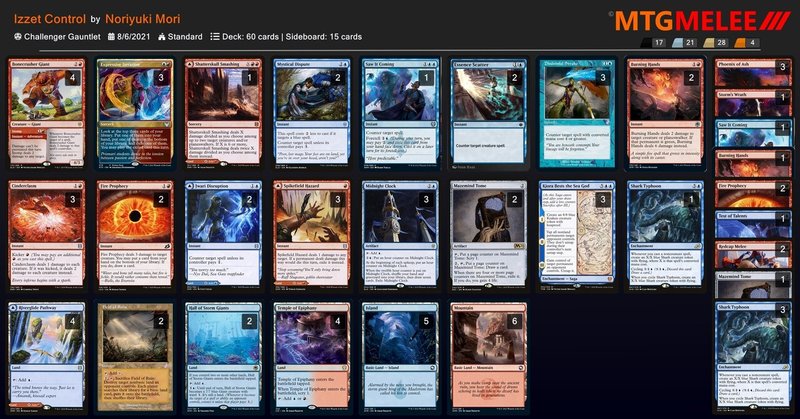
For players like me who aim to outsmart their opponents with decks tweaked against the likely field, it’s not uncommon to find that the deck they have tweaked is actually weak. That’s right, the Izzet Dragon I spent a lot of time working on was weak. I thought it was strong in the current metagame, but it had more weaknesses than I anticipated.
Just before the submission deadline, I decided to switch. With the help of my friends, I was able to make a list that I was satisfied with in a short period of time.
The remaining time to play standard in the current environment is short and there are few events. However, I believe it would be helpful to write about the thought process that went into creating a list that can win the high-level competitive events in MtG in a short period of time.
1.Metagame
First, let’s take a look at the main archetypes that are required to play Standard in the AFR season. I’ll start with the ones that existed in the previous season, and how their positions have changed in the new metagame.
1.1. Gruul Adventure

In the current metagame, two types of aggro are the top tier: Gruul and Naya Winota. AFR gave Gruul Ranger Class and two creature lands that greatly reduced the risk of mana flood. In the Japan Nationals 2021 SEASON 2, it recorded an outstanding 58.6% win rate with 10 players.
1.2. Naya Winota
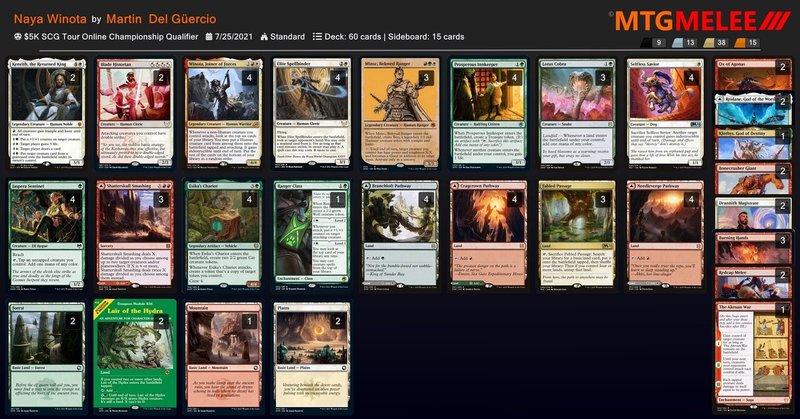
Naya Winota is another deck that showed a significantly increased use at AFR, featuring the two 4 CMC powerful signature cards, Winota and Esika’s Chariot. The addition of Prosperous Innkeeper, which produces treasure, has greatly strengthened this deck by providing ramp for its 4 mana spells and a non-human attacker to trigger Winota. Also, the deck has gained some good parts: Minsc, a human that creates a non-human token, and creature lands, which become a non-human creature when activated. It also has a lot of ways to pass strong moves without allowing your opponent to interfere, such as the indestructible by Selfless Savior and the Elite Spell Binder that increases the mana cost of cards in his opponent’s hand. In the aforementioned Japan Championship 2021 SEASON 2, there were 22 players who used it, and it recorded a high win rate of 58.3%, showing its stable strength in numbers.
1.3. Sultai Ultimatum
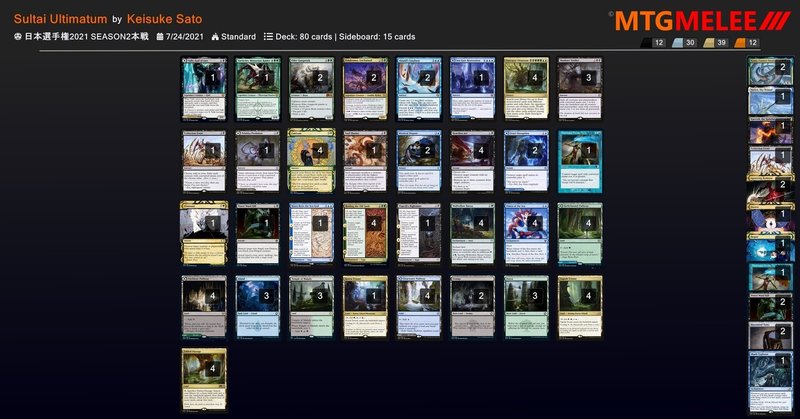
Sultai Ultimatum is a deck that has gone downhill since the rise of the above two decks. At the Japan Championship 2021 SEASON 2, the biggest number of players (31), but its win rate was lower than half (45.3%), indicating its poor position in the metagame.
However, even if it is not in the top meta, it is still very popular, and there are certain players like Sato who are still very successful with it. If you play in the competitive scenes, this is an opponent you want to prepare for.
1.4. Mono Green Aggro
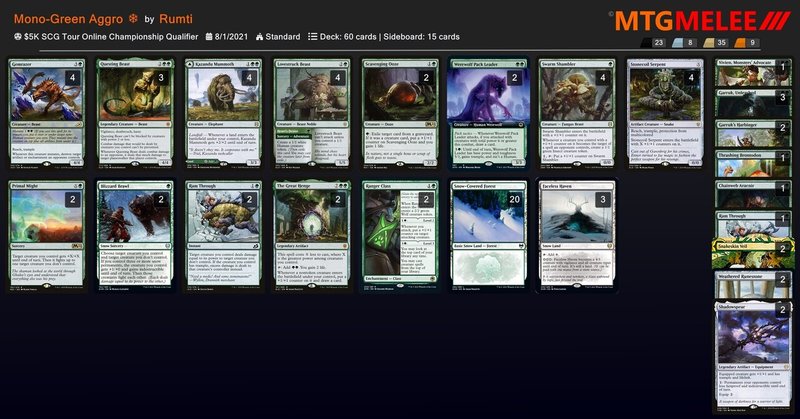
Mono Green aggro had a serious weakness as an aggro deck in the past: it didn’t have much action in the two-mana range. But in the AFR, the addition of powerful two-mana cards such as Werewolf Pack Leader and Ranger Class have made up for that weakness. The deck’s power is so strong that Rumti, shown in the image, won the SCG Tour Online, earning him PT rights. On the other hand, green decks have a weakness for instant timing interference, making it difficult to counter Naya Winota in the top end of the meta.
1.5. Dimir Rogues
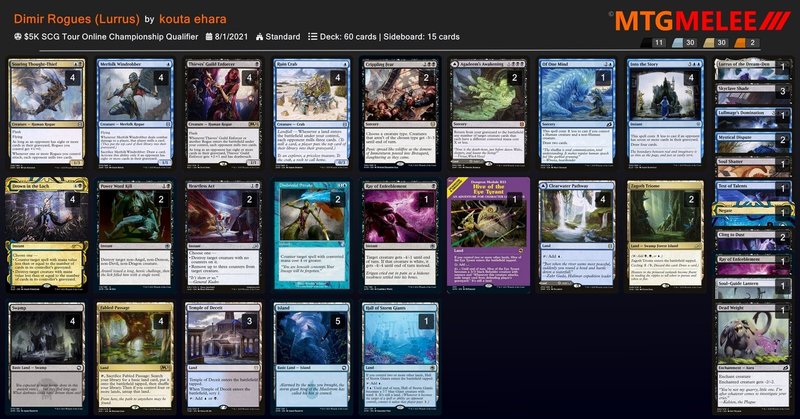
Dimir Rogues is a deck that has a constant win rate and usage rate with a construction that has not changed much since the previous Strixhaven season. If you have the space, you should put a card with the escape keyword in the side as before.
1.6. Jeskai Cycling
Jeskai Cycling is not one of the winning decks in the ARF metagame. However, in terms of metagame changes, it is essential to mention this deck. This is because Jeskai Cycling had a dominant winning percentage in the previous environment. My team member Kazune Kosaka’s list was particularly strong. In the short period of time between 6/26 and 7/5, he and Tomohiro Nakagawa (another teammate of mine) combined to win four MO Challenge championships.
Jeskai Cycling is at a disadvantage against Naya Winota and Green Aggro, both of which have been strengthened by AFR. The nature of the deck, which requires a lot of cycling cards, limits the number of counters that can be used, and it is difficult to interfere Naya Winota’s powerful moves, built on strong four-mana actions. Irencrag Pyromancer, a key card against aggro, is not cheap enough to prevent Winota from being triggered and it cannot remove the toughness 4 Esika’s Chariot. Cycling’s power card, Improbable Alliance, is not a good defense in an environment where Kenrith and Gemrazer can easily give an opponent access to large amounts of trample. Cycling’s tempo and counter tactic of instant tokens and counters is good to Sultai but it is weak in current metagame.
Blue control decks have a chance when cycling becomes weak. Cycling’s Improbable Alliance was deadly to control decks that use removal and counters because it generated sustained creatures easily.
1.7. Summary
Naya Winota and Gruul Adventure are the top two. Cycling, which is weak to these, has faded away. The wind seems to be turning against control. Also, the previous most-played archetype, Sultai, has seen a drop in usage, and it looks like the guard can be lowered a bit.
2. Main Ideas
Let’s talk about the main idea that forms the core of the deck. In addition to Izzet, the other likely blue control deck is Dimir, which has strong removals. I’ll explain why I think Izzet is better than Dimir right now. I will also explain the advantages of it over the existing archetype, Izzet Dragons.
2.1. The Metacard, Cinderclasm
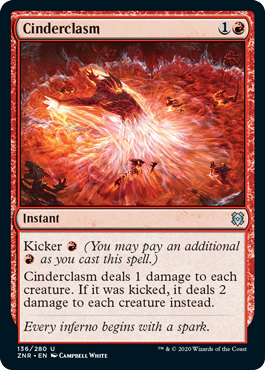
There are two cards in Naya Winota that must be dealt with: Winota, the deck’s namesake, and Esika’s Chariot. As a creature, Winota can be countered with Essence Scatter. However, Esika’s Chariot is an artifact that generates two tokens, so using a single removal will cost you. Therefore, the value of Disdainful Stroke, which can deal with both of them with two mana, has increased.
However, four copies of Disdainful Stroke is not enough to deal with threats of Naya Winota. First of all, one type of card is not enough to deal with a total of eight Winotas and Esika’s Chariot. Secondly, it is bad to draw too many Disdainful Stroke against a deck full of lightweight creatures. That’s why I focused on Cinderclasm. It is not necessary to deal with Winota and Esika’s Chariot directly. For Winota, it is enough to remove non-human creatures needed to trigger its ability and for Esika’s Chariot, it is enough to remove creatures crew it. From this point of view, I felt that Cinderclasm is the best card to play against the lightweight creatures beat decks.
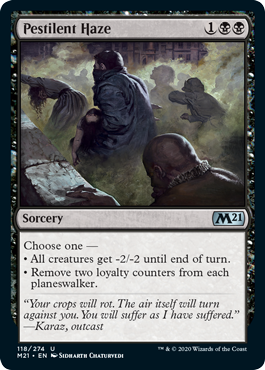
Black also has Pestilent Haze, -2/2 overall. However, if you use it in return for Esika’a Chariot, it will allow your opponent to play Winota, crew Chariot, and trigger it. Against Naya Winota, it is important to move as instant timing.
Cinderclasm is also useful against Gruul. This is because the current mainstream model is filled with 1 and 2 mana creatures, such as Jaspera Sentinel and Magda that lack the 3 toughness of other staples such as Kazandu Mammoth. Being an instant, Cinderclasm can often reliably remove 1/1 creatures before Lovestruck Beast can hit you.
2.2. Bone Crusher Giant, the Strongest Creature in Standard
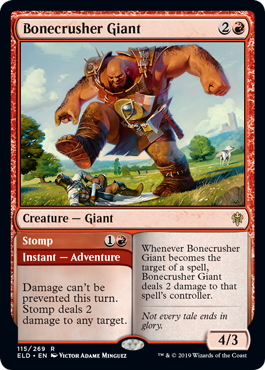
Removal and counters are essentially a 1:1 exchange of cards. Using a control deck with thick removal, repeated 1:1 exchanges often result in a top deck game. The risk of top decking and not being able to deal with the opponent’s threats is a losing pattern that must be considered. Unlike black control, red control has the creature side of Bone Crusher Giant left after the removal is used up. You can win by beating your opponent when he has no resources left. This is an advantage worth giving up the certainty of black removal.
The stats of 4/3 are just right for a matchup with Esika’s Chariot or Wynota, and it doesn’t get killed by your own Cinderclasm. As it is also used in aggro decks, it is easy to plan to go on the offensive. If your opponent is wary of your Cinderclasm and they side in a lot of expensive cards cutting down on their lighter creatures, you can go on the offensive. The game plan of casting Bone Crusher Giant on turn 3 and supporting it with removals and counters is also common against aggro opponents. This kind of flexibility to take advantage of your opponent’s SB plan and go on the offensive early is difficult to achieve with Dimir Control.
2.3. The Optimal and Minimal Finisher, Kiora Bests the Sea God
As mentioned above, I came to the conclusion that Izzet would be the best choice because of the Cinderclasm and Bone Crusher Giant. The first deck I tried was an existing deck, Izzet Dragons. However, this deck’s Goldspan Dragon was weak in this metagame.
First of all, Goldspan Dragon was a target for Redcap Melee and a lot of copies of it are played to kill Winota. In a condition where Disdainful Stroke is stronger than Negate, it was difficult to counter Redcap, and it dies just making one treasure. The kill turn is also too slow. Goldspan Dragon requires 5 attacks to kill an opponent and in an aggro environment where you want to take a lot of smaller actions in lieu of a single bigger one, it was difficult to allocate space for Alrund’s Epiphany. Additionally, Jaspera Sentinel, which has reach, delays your kill turn. I realized that it would be extremely difficult to win the game by playing the Goldspan Dragon, protecting it from removal, dealing with the opponent’s threats, and attacking five times before you lose.
That’s when I turned to Kiora Bests the Sea God.
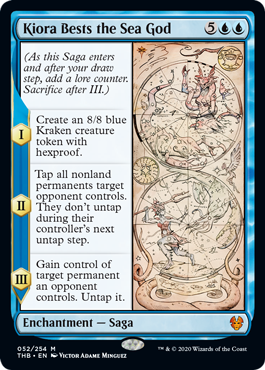
This card makes you win many games by overturning some disadvantages. Since I only needed to draw one of Kiora, it allowed me to add more cheaper actions instead of using 6-7 slots for copies of Goldspan Dragon and Alrund’s Epiphany. When aggro is strong, it’s a big advantage is the ability to devote a slot to a less expensive card. Also, Kiora is both offensive and defensive. The 8/8 token is a solid wall that greatly reduces the risk of lethal on the next turn. Since it’s hexproof, it won’t be a target for your opponent’s spot removal.
It also works well with the new creature lands. Hall of Storm Giants is the biggest of the creature lands in AFR, but it is often blocked by Lovestruck Beast and can’t get lethal. However, with chapters 2 and 3 of Kiora, the attack can go through, and together with the token, it can deal 15 damage at once. If you can attack again, you win.
Although it is heavy at 7 mana, it has the strength of a complete card, unlike the Goldspan Dragon. I settled on Kiora as a finisher because in most cases, it’s easier to put down two more lands than to set up conditions to win with Goldspan Dragon.
This offensive and defensive card contributes not only to the compression of slots for finishers, but also to the compression of some side board cards. When I played it at SCG Tour Online Satellite #1 on July 30, I had Ugin as a side card to deal with Klotys and other enchantments. However, the situations where Ugin is strong were limited, and Ugin hardly survives the opponents turn because creature lands are well played. As I tested, I realized that Kiora alone is enough to deal with it, and I was able to remove “Ugin” to make room for other powerful side cards.
2.4. Another Goal, Midnight Clock
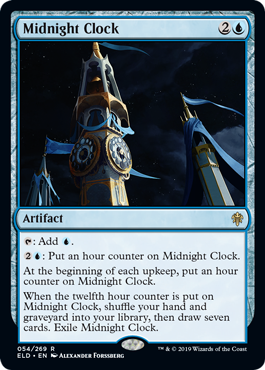
For control decks that need to make 1:1 exchanges and survive until the finisher, finding efficient draw sources is always a tight problem. Against aggro decks, you need to keep playing removals and counters from the beginning. This makes it especially difficult to use mana to draw resources. However, Midnight Clock allows you to boost your mana (helping you cast Kiora earlier.) Since it produces mana the turn it is installed, it costs only 2 and you can draw 7 cards when you run out of cards in your hand after repeated exchanges.
This card is definitely strong. Even if you don’t think about the concept in particular, it is often strong in blue control nowadays. The reason why it didn’t see the light of day despite this is because of the metagame. In the previous seasons, it was a good target for Binding the Old Gods of Sultai Ultimatum. In the ZNR season, the top meta was Gruul with many copies of Embercleave and Great Henge, so artifact removal was often played in the main deck. But what about now? Commonly played artifacts and enchantments such as Esika’s Chariot and Ranger Class generate tokens as part of an ETB effect. Destroying the body of those cards does not solve the problems and the tokens often beat you and you lose. This is why the usage rate of artifacts and enchantments destruction is generally low, creating a condition in which Midnight Clock can easily play an active role.
2.5. Rejecting Brazen Borrower
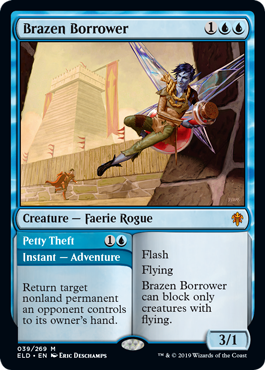
When talking about deck ideas, it is necessary to mention that I did not adopt Brazen Borrower, which is one of the most popular blue cards in Standard. The reason is that it is vulnerable to Gruul and Naya Winota, which I assumed to be the two top decks. These two decks have a lot of cheap creatures and ETBs, so bounce is weak to them. In practice, I didn’t have a good bounce target against Naya Winota, so I had no choice but to use a bounce against a Prosperous Innkeeper’s treasure token, which got sacrificed on stack and Brazen Borrower went to the graveyard. Bounce was weak as a two-mana action, despite the premise that two-mana action is important against aggro. It was also unreliable as a flying clock. Two decks of virtual opponents had Jaspera Sentinel and so Brazen Borrower is only exchanged for a one-mana creature at a time when the opponent thinks it would be bad to be attacked by Borrower any further. In addition, it is hard to get it on the battlefield early because it would get caught up in Cinderclasm and die, so I don’t trust it as a cheap action.
Although Brazen Borrower is works to some extent regardless of the opponent, I judged it to be weak in this event, where the participants were high-level and small number and the list was open.
3. Play Guidelines
3.1. Naya Winota
In:
Fire Prophecy x2, Redcap Melee x2, Storm's Wrath
Out:
Mystical Dispute x2, Burning Hands, Midnight Clock, Shark TyphoonCommon Policy
When to play a counter is important. The three main targets you want to counter are Winota, Esika’s Chariot, and Kenrith. However, the first two can be dealt with by Cinderclasm without playing a counter. Winota is just a creature that is exchanged with Bone Crusher if no non-human creatures are attacking and Esika’s Chariot can be dealt with by killing the creatures which crew it. Kenrith, on the other hand, once it’s on the battlefield, requires two burn spells to remove. Kenrith is the last card on the mana curve, so if you have multiple ways to deal with your opponent’s actions, you may want to leave counters in the hand.
After the SB
There are two factors that can change your strategy after a SB. The first is if your opponent has Klothys, a damage source that is difficult to remove. The second reason is to reduce the number of cheap creatures that can be removed by Cinderclasm and to side in Ox of Agonas, which will give them an advantage in resources and some other heavier cards.
Basically, after sideboard, the value of the creature side of Bone Crusher Giant will increase instead of the value of the adventure side of it decreasing. The reason for this is that if your opponent’s cheap creatures are out and are heavier ones are in, it will be easier for you to make your supporting creatures with counters plan. If you have a Giant in your hand, you should actively cast it on creature side.
Bone Crusher Giant can kill all creatures but Kenrith in combat, and if it blocks Kenrith, it will be in range to fall with a burn spell. If the opponent takes a damage plan with Klothys, Bone Crusher Giant will be the key to your strategy as well. Since Klothys cannot be removed by burn spells, I often use Kiora Bests the Sea God to take control. Klothys is difficult to deal with, but it’s a two-point clock for three mana, so it’s not efficient like a pure clock. If you only look at creatures that participate in combat, the turn they cast Klothys is a pass. You should to be in a position to take the board and protect your life.
3.2. Gruul Adventure
In:
Fire Prophecy x2, Redcap Melee x2, Storm's Wrath, Burning Hands
Out:
Mystical Dispute x2, Disdainful Stroke x2, Midnight Clock, Shark TyphoonCompared to Naya Winotha, this is an easier opponent to play against because it doesn’t have Elite Spell Binder, so it’s harder to break your plan. The biggest difference between Naya Winota and Gruul Adventures is the difficulty of playing Disdainful Stroke. It’s risky to hold on to it because they have strong move after turn 4 that cannot be prevented with it: Edgewall Innkeeper + 3 mana Adventure Creature. You should cast it aggressively when you can. Instead, keep Essence Scatter as much as possible, because it rarely becomes a bad card and can deal with Goldspan Dragon, which can’t be dealt with by a single burn spell.
After the SB, the opponent may play damage sources that cannot be removed by burn spells such as Klothys and Rolling Vortex as well as Naya Winota. After the SB, you should not be on the defensive; create a condition where you can attack with Bone Crusher Giant and put pressure on them.
3.3. Sultai Ultimatum
In:
Shark Typhoon x3, Phoenix of Ash x2, Maze Mind Tome, Saw it coming, Test of Talent
Out:
Cinderclasm x3, Fire Prophecy x2, Kiora Bests the Sea God, Essence Scatter, Bone Crusher GiantThe tokens of Kiora Bests the Sea God can be dealt with by Extinction Event or Shadow’s Verdict, so it’s not nearly a win if you place it, unlike against aggro. It’s better to be able to deter them from casting Emergent Ultimatum or escaping Polukranos when they take control in Chapter 3. Since the opponent has at most three counters in their main deck currently, and is a disadvantageous opponent, the main play is to play Kiora without worrying about if they have a counter.
After the side, there are basically two ways to win.
(1) Tempo and Counter
(2) Resource win with Midnight Clock’s 12 counters.
Which is the better plan depends on your opponent’s SB plan. If your opponent has a lot of removal, (2) is stronger. If your opponent is wary of your Kiora and side-ins a lot of removal and/or hand destruction, then (1) is stronger. Although you want to take the stronger plan possible, the plan you can take depends on your initial hand. For example, if you don’t have many counters, you can’t play counters to Binding the Old Gods and can’t protect Midnight Clock, so you can’t take plan (2).
In (1) and (2), the importance of Maze Mind Tome and Midnight Clock is reversed. In (2), of course, the Midnight Clock is the most important, so you need to play counters at all costs to protect it from Binding the Old Gods. In (1) plan, the game range is short, so it’s more important to have a Tome that can immediately make you draw and improve its quality.
The turn in which you should cast Tome also depends on your plan. Ideally, you cast it on turn 2 on play, but it’s a little more difficult if on draw. If your opponent’s turn 2 action is Wolfwillow Haven, your Tome becomes the target of Binding the Old Gods in return. It is necessary to decide the direction of the game by considering the remaining cards in your hand.
(1) If you have many creatures and few counters in your hand
You can use the Tome as a decoy to make the opponent play Binding to increase your creatures survival rate and set up a short battle.
(2) If you have many counters
If you have a lot of counters, you want to put them at turn 4 to draw at least one card so that you can get into a resource game.
(3) If you have a balance of cards
If both players have a balance of cards, you have disadvantage. If the opponent’s disruption fits you lose. So you should cast it on turn 2 when it has the highest value.
If the Tome is removed immediately after you cast it, it is often reasonable to take Midnight Clock plan, thinking that you have made the opponent use one removal against Midnight Clock. Keep that in mind when you scry with Tome on stack.
3.4. Dimir Rogues
In:
Ash Phoenix x3, Shark Typhoon x3, Fire Prophecy x2, Storm Wrath, Talent Test
Out:
Kiora, Strike Down the Sea God x3, Contemptuous Strike x3, Burning Hands x2, Burning Hell x2If your Midnight Clock are solved, you have a huge advantage, otherwise you have a disadvantage on G1.
A match where Kiora is not strong. The token is exchanged with Thieves’ Guild Enforcer, and the opponent’s permanents are cheap, so there are no cards that can be taken away in chapter 3 to give you a special advantage.
As Kiora is not strong, there are two plans you can take.
1) Win by resource with Midnight Clock.
2) Beatdown with multiple Bone Crusher Giant.
Midnight Clock is extremely powerful and can deny your opponent’s LO plan, so we would go for (1) if possible. In the current environment, it is rare to play Mystical Dispute or Negate in the main deck, so Midnight Clock on turn 3 on play is rarely countered. If they don’t have the two cards mentioned above, the only thing that can counter your Clock is turn one Ruin Crab and turn 2 Drown in the Loch. If you have few cards in the graveyard, your opponent’s creatures’ powers are greatly reduced.
We don’t have many ways to deal with creatures with 3 toughness. If you assume rogues is heavily played, you can replace the Burning Hands with Fire Prophecy from the beginning. Cards you want in initial hands are as follows; Mystical Dispute to stop your opponent’s early strong moves, Fire Prophecy, Bone Crusher Giant to start a damage race, and Midnight Clock as a killer card. The main game is basically a disadvantage, so I take value and mulligan if I don’t have many effective cards.
After the SB
With the increase of Fire Prophecy and the side-in of Phoenix of Ash, the matchup improves. The strength of Ash Phoenix related to Ox of Agonas is the flexibility to switch between using it as a blocker and an attacker for beat down. Whether to use it as a blocker or an attacker depends on the opponent’s plan.
(1) LO main plan without side-out Ruin Crab
Basically, beat down because the time limit is short. However, if you can put Midnight Clock, you can use it as a blocker and go to a resource game.
(2) Beatdown plan with side-in Skyclave Shade
In most cases, Ruin Crab is side-outed, so you have time to go to a resources game. Unless you put down Bone Crusher Giant turn 3 on play, it is safe to use it as a blocker and play a resource game since your opponent has higher hitting points.
3.5. Mono Green Aggro
In:
Fire Prophecy x2, Burning Hands, Storm's Wrath
Out:
Disdainful Stroke, Midnight Clock, Shark Typhoon, Mystic DisputeDisadvantage because of many big size creatures that are hard to deal with by red removals. If you can Cast Kiora, you generally win, but you don’t have enough effective removal to get there. In order to win the game, I thought I had no choice but to hope every card you play fit the situation, so I left two 3 mana counters, which is little many for an aggro opponents. This is because four 4 copies of Burning Hands are not enough against the opponent’s larger creatures. Burn spells other than Burning Hands won’t be able to kill big creatures like Lovestruck Beast. However, they can be killed after combat with Bone Crusher Giant, so you should play Bone Crusher Giant when you can so that creatures with high toughness don’t keep attacking you. If you allow the opponent to make Gemrazer that is too big to kill even with 2 cards, you will lose. However, even if the opponent has a creature to mutate, you are at a disadvantage, so if it looks like you can’t win, hope they don’t have Gemrazer and play Bone Crusher Giant.
3.6. Dimir Control
In:
Shark Typhoon x3, Ash Phoenix x3, Maze Mind Tome, Saw it Coming, Test of Talent
Out:
Out: Cinderclasm x3, Fire Prophecy x2, Burning Hands x2, Essence ScatterThe opponent’s removals hit our Bone Crusher Giant, but we need to use 3 or more removals to kill Lochmere Serpent, so I’m at a big disadvantage in the main game. The Midnight Clock has an advantage in a resource game, but the percentage of dead cards in the deck is too high. Kiora’s tokens are also dealt with by Extinction Event and Shadow’s Verdict.
The key is whether or not you can take something good with Kiora chapter 3. If Kiora passed, they can’t cast Lochmere Serpent until the end of Chapter 3. You should move backwards so that Kiora becomes stronger. I play with the sequence of events in mind, from forcing my opponent to use removal and counters by casting Bone Crusher Giant, Midnight Clock, and activating a creature land, to casting Kiora. After the side, thanks to Phoenix of Ash, you will often have more creatures to cast than your opponent’s removals, so your compatibility will improve greatly.
4. Under What Circumstances Should You Play This Deck?
Control decks’ strength is affected much by the metagame. The type of strong removals and counters depends on the metagame, and there are options to play other control decks such as Dimir. So let’s think about when we should play this deck.
Open/Non-Open list
There are two types of systems: non-open list, where you can’t see your opponent’s deck like Arena ladder, and open list, where you can see your opponent’s deck like events on MTGMelee. When you play Izzet control, you doesn’t want to keep burn spells for control players and counters for aggro players. It is more likely to play in open list. However, nowadays, it is easy to guess the archetype by the opponents’ companions, such as Yorion for control and Lurrus for rogues. The archetypes that change the mulligan criteria significantly can be identified by their companions, so it is relatively easy to use in non-open list. However, if 60-cards control becomes popular, it is risky to use in non-open list.
Strengths against the environment
Izzet color has the advantage of being able to flexibly switch between offense and defense thanks to the Bone Crusher Giant. While it is flexible against certain opponents, it is not versatile enough to be used against a variety opponents. We can’t remove enchantments, it’s difficult to deal with big creatures, and the type of strong counters depend on the metagame. Therefore, best timing to play it is when you expect the metagame to be somewhat polarized.
5. Adjustment Guide
The current list has been adjusted based on the assumption that Gruul Adventures and Naya Winota will be at the top of the metagame. If this assumption falls apart, the list itself will need to be updated. Here is the guide on how to update the list. (I’m not going to go over the in-and-out from the main deck that I wrote about in the Playing Guidelines, since it’s common to all opponents. )
5.1. Dimir Rogues
Current awareness: A little
Room for improvement: Large
Clearly Mystic Dispute is strong among counters. Disdainful Stroke is weak. You should prioritize Mystic Dispute as a counter in the main deck. Since the 3 damage of Fire Prophecy is important, it is best to replace the main Burning Hands with a Fire Prophecy from the beginning.
5.2. Sultai Ultimatum
Current Awareness: Not much
Room for improvement : Large
In contrast to Rogues,, Burning Hands is stronger than Fire Prophecy due to the presence of Elder Gargaroth. Also, there are many situations where Saw it Coming is stronger than Mystical Dispute. In particular, if the game range is to be redrawn with Midnight Clock, the opponents can easily pay the extra 3 manas. It is better to change the distribution in this area.
5.3. Mono Green Aggro
Current awareness: Not at all
Room for improvement: Small
The number of Burning Hands you draw is a big factor in whether you win or lose, so you want to have as many as possible in your main deck, not to mention 4 in total. Essence Scatter is also a valuable card that can deal with your opponent’s actions for two mana, so you want to increase the number of it.
5.4. Izzet Mirror
Current Awareness: Not at all
Room for improvement: Extremely large
It’s like a rock-paper-scissors game with Disdainful Stroke countering Kiora, Shark Typhoon slipping through Disdainful Stroke and Kiora, which has more control than Shark Typhoon’s tokens. There is no universally correct answer, because where to go is a matter of interpretation.
In both plans, the player who gets the most advantage with the Midnight Clock and Maze Mind Tome often wins. Destroying them with Prismari Command is another option.
After SB, Shark Typhoon will undoubtedly be side-in, so Brazen Borrower that can remove shark tokens and reset Midnight Clock’s counters is both strong and has little downside.. However, if you put it in the main deck, it will just be a target for otherwise dead removal, so I recommend putting it in SB.
5.5. Dimir Control
Current awareness: Not at all
Room for improvement: Large, but also with great risk
Simply replacing the removals with counters or draw spells will greatly improve the situation. However, if you do so, the efficiency against aggro in general will suffer, so the risk is great. In a such metagame, it’s safer to play a different deck if you can.
5.6. Naya Adventure
Current awareness: Almost none
Room for improvement: Small
If you pass through Skald’s Showdown more than 2 turns earlier than Kiora, you’re done. However, because of their high amount of 3 mana actions, it’s hard to trust Disdainful Stroke. I’d like to replace some counters with Negate because adventure creatures makes it less likely to be a dead card.
